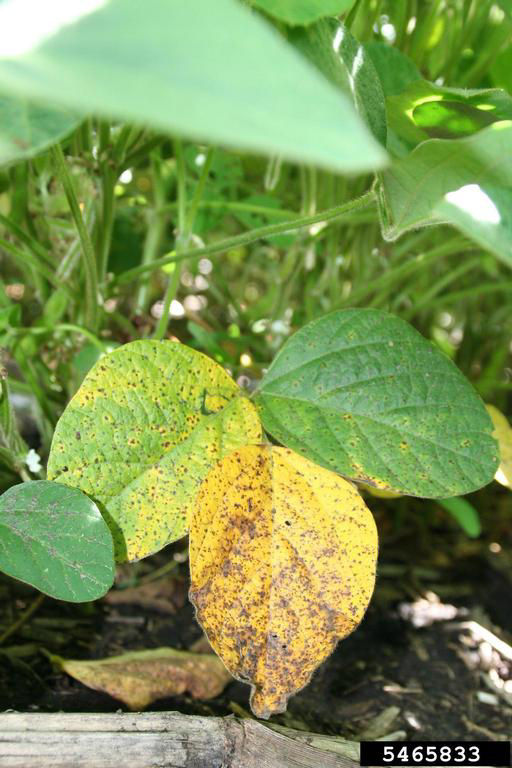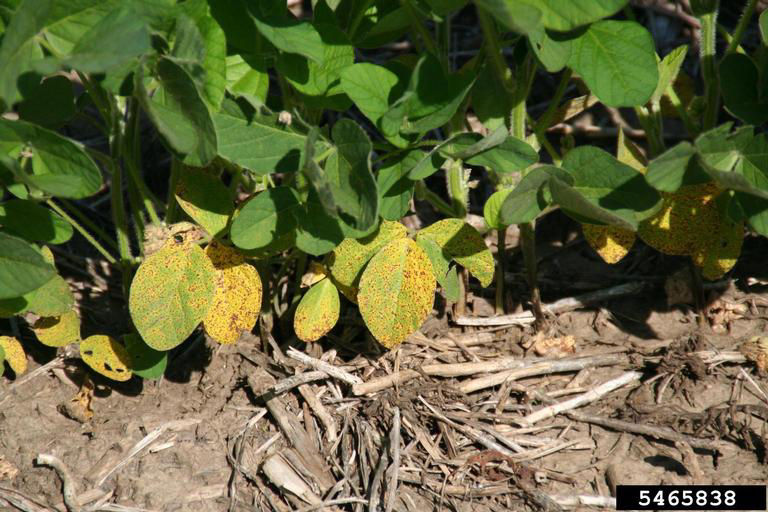5 MIN READ
Management of Septoria Brown Spot in Soybean
November 14, 2023
Septoria brown spot (also known as brown spot) is caused by the fungal pathogen Septoria glycines. It is a common disease of soybean in the Midwestern United States. Significant yield loss from Septoria brown spot is rare. It most commonly occurs after an extended period of warm, wet weather. Continuous cropping and minimum tillage soybean fields are more likely to be infected.
Symptoms and Biology
Septoria brown spot overwinters and sporulates on soybean residue. The disease is spread by wind and splashing rain that moves spores from the soil surface and from residue onto growing plant tissue. Temperatures between 60 °F to 85 °F (15 to 29°C) and prolonged wet periods favor Septoria brown spot development while hot, dry weather can often inhibit the disease. The disease cycle continues on infected plants during favorable conditions. Brown spot symptoms are generally mild during early growth stages but can appear on the cotyledons and unifoliate leaves. Spores that have developed on cotyledons and unifoliate leaves provide the inoculum for later infections of trifoliate leaves, stems, pods and surrounding plants.1,2
Small, irregular, dark-brown spots occur primarily on leaves (Figure 1) and can develop on upper and lower leaf surfaces. Symptoms occur first on lower leaves and then progress upward into the canopy. Tissue surrounding lesions may become yellow. Late in the growing season, leaves can become rusty brown or yellow in color and drop prematurely. Defoliation typically proceeds from the bottom of the plant moving upward toward the top of the canopy.
Septoria brown spot can be confused with bacterial blight (Pseudomonas sp. infection). Lesions caused by bacterial blight are irregular and brownish, surrounded by a yellow ring or halo, and may appear water-soaked. The lesions turn dark as they mature and drop out of the leaf, giving the leaf a tattered appearance. Other differences include the spore-producing specks that are characteristic of brown spot and are absent with bacterial blight. Also, brown spot tends to remain lower in the canopy while bacterial blight is more prevalent in the middle to upper portions of the soybean canopy (Figure 2).1,2


Impact on a Soybean Crop
Brown spot is common in the Midwest and incidence can be high, though it is rare for the disease to cause significant yield loss. Yield losses that do occur may be a result of hastened maturity of the crop caused by premature defoliation. It has been estimated that 25 to 50 percent premature defoliation can affect soybean productivity or result in smaller seed size. Five to eight percent yield loss may be possible in severely diseased fields where there is much defoliation. Across the United States, yield losses as high as 15% have been reported.2,4
Management Tips
- Fungicides from the strobilurin family may prevent or reduce disease development if applied prior to symptoms. In the rare event that a severe infection appears to be developing, an application of a foliar fungicide is generally recommended at the R3 to R4 growth stage.4
- Select a soybean product with some tolerance to the disease; resistant products are not available.
- In fields with high levels of infection, the incorporation of residue with tillage can help to increase the rate of decay and reduce the amount of inoculum that could potentially infect future soybean crops.
- Rotation to non-legume crops for at least one year can also help reduce the incidence of Septoria brown spot.
Sources:
1 Dorrance, A.E. and Mills, D.R. 2011. Brown spot of soybeans. The Ohio State University Extension. Fact sheet AC-18. https://ohioline.osu.edu/factsheet/AC-18
2 Malvick, D. Septoria brown spot. Crop Diseases. University of Minnesota Extension. https://extension.umn.edu/soybean-pest-management/septoria-brown-spot
3 Giesler, L.J. and Miller, J.J. 2017. Managing foliar diseases in soybean. University of Nebraska Extension. NebGuide G1862. https://extensionpublications.unl.edu/assets/html/g1862/build/g1862.htm
4 Giesler, L.J. 2011. Brown spot of soybean. University of Nebraska-Lincoln Extension. NebGuide G2059. https://extensionpublications.unl.edu/assets/pdf/g2059.pdf
Web sources verified 10/20/2023 1311_62251